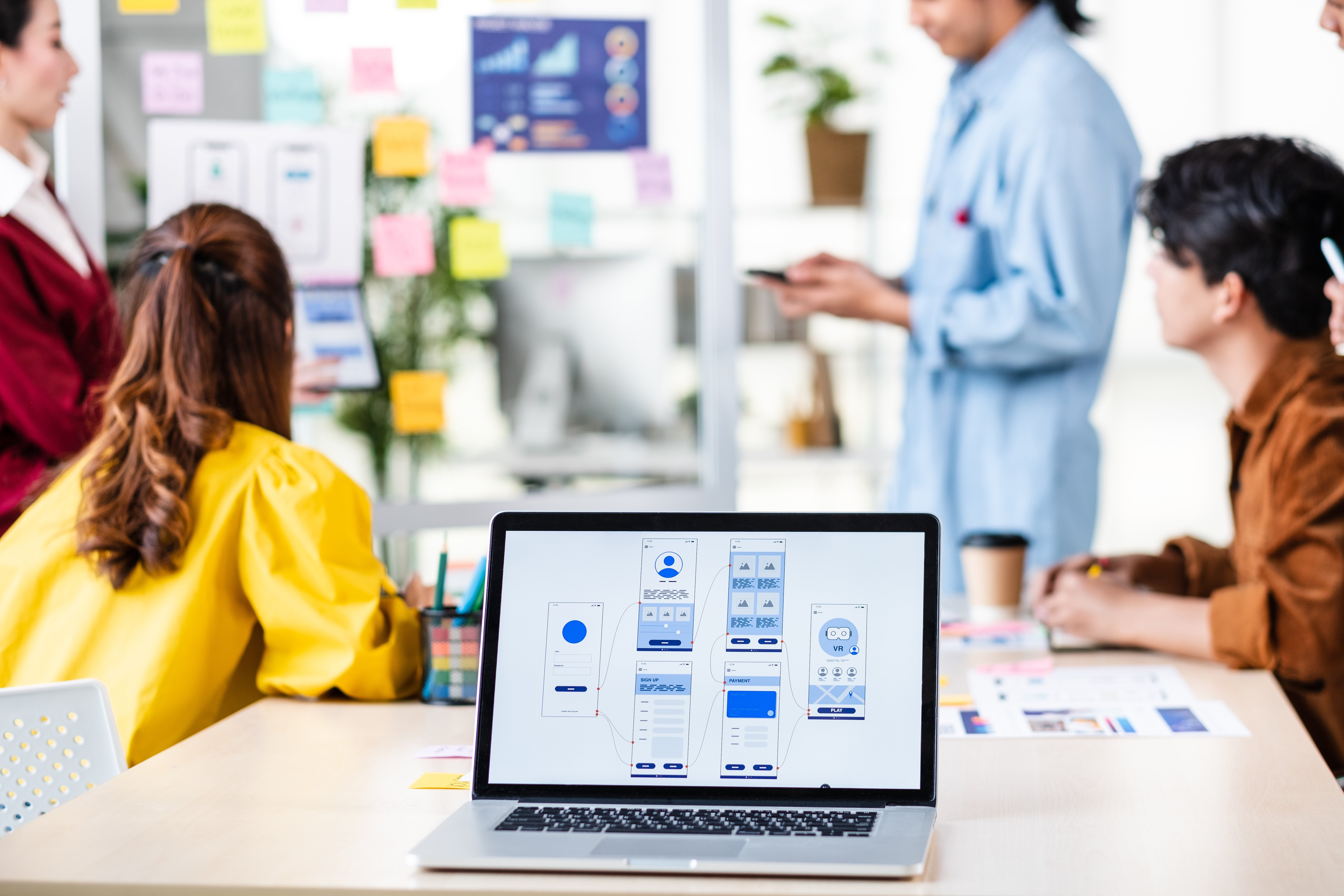UX and UI: What Are the Differences?

The terms UX (User Experience) and UI (User Interface) are often thrown around, sometimes interchangeably, leading to confusion.
Understanding the difference between UX and UI is crucial for designers and businesses aiming to create exceptional digital products. In this blog, we will explore and understand the definitions of UX and UI along with their differences and correlation.
What is User Experience?
User experience (UX) is the holistic result of how users interact with a product or system. Imagine it as the overall vibe you get while using a website, app, or any digital platform. A UX designer is like an architect who shapes this experience, ensuring it's smooth, enjoyable, and aligns with user needs.
Interaction design is a crucial part of UX. It's about creating the pathways users take within a product—the buttons they click and the menus they navigate. Think of it as designing a user-friendly road system within a city. The UX designer maps out these routes, making sure users can effortlessly get from point A to point B without roadblocks.
UX is not just about how things look, but also about how they function. Design, in the context of UX, is the process of crafting both appearance and functionality so that they work seamlessly together. It's like making sure the gears and gadgets inside a watch not only look good, but also keep accurate time.
Basically, user experience design is all about making sure users can easily and happily interact with a product; it’s the art and science of creating a delightful journey every time someone engages with digital technology. Now that we understand what UX is, it’s essential to understand the role of a UX designer.
Key Aspects of UX Design
- User Research: Understanding the target audience and their needs through surveys, interviews, and analytics.
- Information Architecture: Organizing and structuring content to facilitate a seamless user journey.
- Usability Testing: Iteratively testing prototypes to identify and address usability issues.
What Does a UX Designer Do?
Here are some roles and responsibilities of a UX designer.
- Graphic Design Integration: UX designers seamlessly merge graphic design elements to enhance the overall user experience.
- Collaboration with UI Designers: Close collaboration with UI designers ensures a unified and visually appealing interface.
- User-Centric Focus: UX designers prioritize user needs and preferences, shaping experiences around their expectations.
- Process Streamlining: They streamline processes for efficiency, simplifying user interactions and ensuring a seamless experience.
- UI Designer Collaboration: While UI designers address visual aspects, UX designers focus on the broader user journey and functional aspects.
- Holistic User Experience: UX designers consider the entire user journey, from the initial interaction to long-term engagement, ensuring a comprehensive and satisfying user experience.
What is User Interface?
A user interface (UI) is the point of interaction between a user and a digital device or application. It encompasses the visual elements, such as buttons, icons, and screens, that users interact with to navigate and engage with the system. UI design focuses on creating an intuitive and visually appealing interface to enhance the user experience.
User interface design is a pivotal aspect of product design, influencing how users perceive and interact with a digital product. Whether it's web design or application development, effective UI design is essential for a positive user experience, guiding users through a smooth and visually coherent journey. Ultimately, a well-executed UI design enhances usability, encourages engagement, and contributes to the overall success of digital products.
Key Aspects of UI Design
- Visual Design: Crafting a visually pleasing interface that aligns with the brand's identity.
- Interaction Design: Ensuring that user interactions with the product are seamless and intuitive.
- Responsive Design: Adapting the interface to various devices and screen sizes for a consistent user experience.
What Does a UI Designer Do?
Here are some tasks for a UI designer:
- UI Design Process: Engaged in the UI design process, they meticulously design buttons and clickable elements while considering both aesthetics and functionality.
- Visual Brand Representation: UI designers play a crucial role in product and web design by choosing appropriate colors, fonts, and typesetting to create a visually cohesive brand representation.
- Brand Style Guides: They create and maintain brand style guides, ensuring consistent implementation of a brand's visual identity throughout a product or service.
- Accessible Design Standards: UI designers uphold accessible design standards, making sure the interface is usable for all users.
- Interactive Elements: They develop animations and interactive elements, incorporating visuals like videos and photos to enhance user engagement.
- Flexible Layouts: UI designers create flexible layouts, managing how content moves and ensuring easily resizable vector elements.
- Responsive Design Style Guides: They manage responsive design style guides and contribute to the development of adaptable and user-friendly interfaces.
Why are UX and UI Crucial for Business?

User experience (UX) and user interface (UI) design are crucial for businesses as they directly impact the success and perception of digital products and services.
UX Design Focus: UX design focuses on creating a seamless and satisfying user journey. A good UX design ensures that users can easily navigate through a product, understand its functionality, and achieve their goals efficiently. It involves understanding user behaviors, conducting usability studies, and iterating on designs to eliminate friction points.
UI Design Specifics: UI design is virtually the face of a product. It involves the creation of a visually appealing and user-friendly interface. Great UI design considers aesthetic principles, brand guidelines, and usability standards. It encompasses designing buttons, layouts, color schemes, and other visual elements. A good UI is specific, guiding users through a product with clarity and enhancing overall user satisfaction.
Business Impact
- Customer Satisfaction: UX and UI design contribute to positive user experiences, leading to increased customer satisfaction and loyalty.
- Brand Image: Aesthetically pleasing and functional designs create a positive perception of the brand, boosting its image.
- Competitive Edge: In a market where user experience is a key differentiator, businesses with great UX and UI gain a competitive edge.
- Reduced Bounce Rates: Bad UX can lead to frustration and high bounce rates, while good UX keeps users engaged, reducing bounce rates.
- Conversion Optimization: A well-designed UI enhances the user's journey, contributing to better conversion rates and increased revenue.
- Cost Savings: Investing in UX and UI design early in the development process helps identify and address issues, preventing costly redesigns later.
UX and UI design skills are essential for creating online products that not only meet user needs, but also contribute significantly to the success and profitability of businesses.
Skills Required for UX and UI
- Collaborative Skills: UX designers often work closely with UI designers to ensure a cohesive interface.
- Problem Solving: UX designers might encounter challenges and require adept problem-solving skills.
- Construction of Interfaces: UI designers build visually appealing and functional interfaces.
- Assistance to UX: UI designers help UX designers translate user insights into tangible design elements.
- Research Proficiency: UX researchers contribute to informed decision-making in the design process.
- Synergy Between UX and UI: UX and UI design are two interconnected aspects of creating effective digital experiences.
- Creation Focus: Design, whether UX or UI, is all about creating engaging and user-centric solutions.
- UI Definition: UI stands for User Interface, emphasizing its role in user interaction and visual design.
Now that we have a clear-cut understanding of both UX and UI, let’s consider the key differences between the two.
Differences Between UX and UI
|
Aspect |
UX (User Experience) |
UI (User Interface) |
|
Definition |
UX design is the process of enhancing user satisfaction by improving the usability, accessibility, and pleasure provided in the interaction with a product. |
UI design is the process of creating visually appealing and interactive interfaces to facilitate effective communication between users and digital products. |
|
Part of the Design Process |
UX is a crucial aspect of the design process, focusing on the overall user journey and satisfaction. |
UI is part of the design process, emphasizing the visual elements and user interface of a product. |
|
Examples |
Examples of UX design include user research, wireframing, and prototyping to ensure a seamless and enjoyable user experience. |
Examples of UI design include designing buttons, layouts, and color schemes for a visually attractive and user-friendly interface. |
|
Tasks of Designers |
UX designers map user journeys and focus on the overall experience, while UI designers create visually appealing and functional interfaces. |
UI designers might create interactive elements and animations and consider the aesthetics to enhance the visual appeal of a product. |
|
Collaboration and Focus |
UX and UI designers typically work together, with UX focusing on the broader experience and UI concentrating on the visual and interactive aspects. |
UX designers must understand user needs, while UI designers ensure these needs are translated into visually pleasing and intuitive designs. |
|
Relationship Analogies |
"UI without UX is like a painter without a canvas; it may look good, but it lacks substance and usability." |
"UX without UI is like a beautiful skeleton with no skin; it might function well but lacks the visual appeal and user engagement." |
|
Design Integration |
UX and UI design work together to create a seamless and delightful digital experience. |
Designers use UX and UI to ensure a holistic approach, incorporating user needs and visual aesthetics into the overall design. |
|
Career Focus |
UX designers focus on understanding user behavior and creating meaningful experiences. |
UI designers concentrate on creating visually appealing and intuitive interfaces that align with a brand's visual identity. |
|
Digital Design Impact |
UX encompasses the entire user journey, considering usability, accessibility, and satisfaction. |
UI focuses on the visual aspects of a digital product, creating a visually cohesive and engaging interface. |
|
Use of Design Skills |
UX designers use design skills to map user experiences and streamline processes. |
UI designers use design skills to create visually appealing elements, such as buttons, layouts, and color schemes. |
|
Research and Insights |
UX researchers contribute to informed decision-making by gathering insights into user needs and behaviors. |
UI designers might use insights to enhance the visual appeal and usability of the interface. |
|
Design Teams |
Design teams often consist of both UX and UI designers, working collaboratively to achieve a balance between user experience and visual aesthetics. UX designers also work with other stakeholders. |
Designers use their collective skills to integrate UX and UI, ensuring a harmonious and effective design. |
|
Digital Product Examples |
UX leads to a product that users love to interact with due to its efficiency and user-friendly design. |
UI contributes to a product's visual appeal, making it visually pleasing and enticing to users. |
|
UX and UI Go Together |
Integral partnership, with each enhancing the other. |
Interconnected aspects, combined for an effective user experience. |
|
UX Without UI is Like |
A well-designed façade lacking substance and functionality. |
A beautiful interface lacking seamless user experience. |
|
Digital Design |
Incorporates a broader understanding of user interactions. |
Focuses on the visual and interactive elements in digital interfaces. |
|
Great UX |
Creates a positive and satisfying overall user experience. |
Ensures a seamless and enjoyable user journey. |
|
Great UI |
Enhances the visual appeal and interaction of a product. |
Ensures visually appealing and user-friendly interfaces. |
|
UX Encompasses |
The entire user experience, from discovery to post-interaction. |
User interactions and satisfaction throughout the journey. |
|
UX Insights |
Derived from user research and understanding of behaviors. |
Informs the design based on visual and interactive preferences. |
|
Understanding UX vs UI |
Recognizing the interdependence for a holistic approach. |
Distinguishing the visual elements and their interactive impact. |
|
Examples of UX |
Intuitive navigation and personalized content delivery. |
Smooth onboarding, error handling, and task completion. |
Trends and Challenges in UX and UI

Trends
- AI-Powered Design Assistance: UX/UI designers are increasingly leveraging AI tools to streamline the design process. AI assists in generating design elements, providing data-driven insights, and automating repetitive tasks, allowing designers to focus on strategic and creative aspects.
- Augmented Reality Integration: As AR technologies gain prominence, UI designers face the challenge of seamlessly integrating virtual elements into real-world interfaces. The technical aspect involves optimizing visual fidelity and ensuring intuitive interactions within augmented environments.
- Biometric User Authentication: The rise of biometric authentication necessitates that UI designers implement secure and user-friendly biometric interfaces. Designing around biometric data involves encryption, ensuring data privacy and creating interfaces that align with the technical requirements of various biometric sensors.
Challenges
- Cross-Platform Consistency: Unlike UX challenges, ensuring consistent UI across diverse platforms is a persistent technical hurdle. UI designers must navigate the intricacies of different operating systems, devices, and resolutions while maintaining a uniform visual language.
- Technical Debt in Design Systems: Design systems are pivotal, but accruing technical debt in these systems can impede efficiency. UX/UI designers need to proactively manage and refactor design systems to prevent technical debt, ensuring scalability and ease of maintenance.
- Designing for Accessibility: Design is all about creating inclusive experiences. UI designers, unlike UX designers, need to meticulously consider technical aspects of accessibility, ensuring adherence to Web Content Accessibility Guidelines (WCAG), screen reader compatibility, and seamless navigation for users with diverse needs.
- Integration of Haptic Feedback: The UI designer’s focus on creating interfaces extends to incorporating haptic feedback for tactile interactions. Unlike UX, where overall experience is prioritized, UI designers need to consider the technical specifications of devices to deliver precise and responsive haptic feedback.
The role of a UX or UI designer goes beyond creating static interfaces; it involves making UX that considers emerging technologies and UI that adapts to dynamic user preferences. The future of UX and UI design lies in creating experiences that seamlessly blend technology, aesthetics, and user-centricity.
The Future of UX and UI
As technology continues to advance, the future of UX and UI design holds exciting possibilities. The integration of artificial intelligence, augmented reality, and voice interfaces will likely redefine the way users experience digital products. Additionally, the emphasis on inclusivity and accessibility will play a pivotal role in shaping the future of user-centered design.
How UX and UI Design Work Together
UX (User Experience) and UI (User Interface) design work collaboratively to create digital products that are visually appealing, intuitive, and user-friendly. Let's explore how these two disciplines come together in a seamless partnership.
UX and UI Designers: A Collaborative Duo
UX designers concentrate on the overall user journey, working to understand user needs and behaviors. On the other hand, UI designers focus on the visual elements of a product, ensuring that it looks aesthetically pleasing and is easy to navigate.
UX Design and UI Design: Two Sides of the Same Coin
UX design is the structural framework; it defines the overall flow, ensuring users can easily achieve their goals. On the other hand, UI design is like the outer shell; it involves creating buttons, icons, colors, and layouts that users interact with directly. Together, they ensure a product not only looks good but also functions seamlessly.
UX Tasks Followed by UI
In a typical design process, UX often precedes UI. UX designers conduct user research, create wireframes, and define the information architecture. Once this foundation is laid, UI designers step in to add the visual layer, incorporating colors, typography, and imagery that align with the user-centric principles established by UX.
The UX Designer’s Influence on UI
A UX designer's insights heavily influence UI design. Understanding user needs and behaviors allows UX designers to guide UI designers in creating visual elements that resonate with users. This collaboration ensures that the UI not only looks good but also enhances the overall user experience.
UX and UI design are intertwined, with each discipline enhancing the other. The collaborative efforts of UX and UI designers result in digital products that not only catch the eye but also provide a smooth and satisfying journey for users, creating a harmonious blend of aesthetics and functionality.
In essence, UX and UI are integral components that work hand in hand to create products that not only look visually appealing but also provide a delightful user experience. Understanding the differences between UX and UI is crucial for designers, product managers, and anyone involved in the creation of digital products. By recognizing the unique roles each plays and fostering collaboration between UX and UI, designers can contribute to the development of products that resonate with users and stand out in the competitive market.
Feel like you could use a hand?
See what’s possible and give your teams the ability to create positive change.
Contact NowElevate your tech savvy! Warning: May cause increased knowledge.
Exclusive technology and development insights, tips, and podcasts await.
%20Design%20Process%20for%20a%20Web%20App__Hero.jpeg?width=352&name=24Jan_%20What%20is%20the%20User%20Experience%20(UX)%20Design%20Process%20for%20a%20Web%20App__Hero.jpeg)
%20in%20Mobile%20App%20Development__Hero.jpeg?width=352&name=12Jan_Importance%20of%20User%20Experience%20(UX)%20in%20Mobile%20App%20Development__Hero.jpeg)
